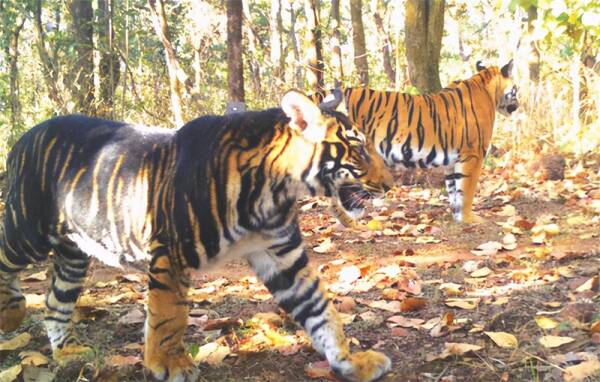There is a kind of tiger with a special color, black and blue with dark black stripes on it. Its name is blue tiger, also known as black tiger and black and blue tiger. According to historical records, mysterious blue tigers are distributed in Fujian, Hubei, Hebei, Sichuan and other places. Blue tigers have been discovered more than once in Miyun, Beijing. But because there is no imaging data, most people have doubts, does the mysterious blue tiger really exist?

However, there are really blue tigers in India! At present, traces of blue tigers have only been found in India, with only 6 individuals, which is very rare.
Blue tiger is a rare tiger species in China and is legendary. In China's first dictionary "Shuowen Hubu" it is said: Lin is also a black tiger. It is said that blue tigers were discovered in Hebei during the Qing Dynasty. Moreover, in 1905 and 1912, blue tigers were hunted twice in Hebei.

In 1924, an American claimed to have discovered a blue tiger in Fujian, and wrote a book "Blue Tiger" to record how he discovered the blue tiger and its shape. "The patterns on this beast are very beautiful, and the background color is very beautiful." It’s blue-grey with distinct stripes.”
In 1951, a pair of small blue tigers were discovered in Miyun, Beijing.
In 1957, the mysterious blue tiger appeared again in Miyun, Beijing. Eyewitnesses said that the blue tiger was strong and had dark black markings on its light black fur. It was always active at night and hunting for prey. Local people said that because of the ferocious blue tiger in the mountain forest, the wolf has never been seen again. It can be seen that the blue tiger is so powerful in the mountains and forests that the wolves do not dare to approach within a ten-mile radius and do not dare to compete with the blue tiger for food resources.
In the 1970s, staff at the Shilipal Tiger Reserve discovered two adult blue tigers, but there was no imaging data.
In 2007, three blue tigers were captured by an infrared camera in the Siripal Tiger Reserve, causing a sensation. After that, traces of blue tigers were also found many times.
In November 2020, a photographer accidentally photographed two sturdy blue tigers in the Shilipal Tiger Reserve. He said: "I couldn't believe my eyes when I saw blue tigers for the first time." Photography The blue tiger in the teacher's photo has the same body shape as an ordinary tiger, but its thick black markings are impossible to ignore. The black on the back is the most concentrated. The back is as black as splashed ink, and there are yellow hairs on the sides. The limbs are mostly yellow, while the tail is almost completely black, and the black lines on the forehead are also very thick. The white spots on the two ears are more obvious against the black background, a bit like two "big eyes". Judging from the body color alone, it is somewhat different from the blue tiger recorded in our country's history.

Two blue tigers were strolling leisurely. After walking for a while, they simply squatted down and yawned lazily. After a while, he got up and walked into the woods, wandering freely in the woods.
Currently, only 6 blue tigers are found in the Shilipal Tiger Reserve. Of course, the previously reported blue tigers are questionable due to lack of evidence in the wild, but this does not mean that the witnesses fabricated the existence of blue tigers.
According to the monitoring of the reserve, blue tigers will go out no matter day or night, but they are very leisurely during the day. Sometimes they lie on the ground and rest, as lazy as a cat. Sometimes they wander around, taking their time, as if they are on vacation. .
But at night, the lazy big cat Blue Tiger turns into an excellent hunter. The dark body color blends with the dark night. When it runs quickly through the forest, it is as mysterious and swift as a ghost.
The main food of the blue tiger is wild boar and wild deer, especially the meaty wild boar. The blue tiger chased a wild boar weighing about 300 kilograms at night, very fiercely. After tracking the wild boar, he hit it with one strike, but the wild boar had thick skin and thick flesh and was difficult to deal with. It used brute force to rush around, trying to knock off the blue tiger and escape. Blue Tiger jumped to the side, flexibly avoided the wild boar's collision, went around the back of the wild boar, and attacked the wild boar from behind. After fighting for a while, he finally captured the wild boar. After a full meal, you can go without food for 5 days.

Blue tigers don't look much of a deterrent when they are lazy, but when hunting, they are strong, agile, wild and powerful. At this time, the blue tiger will attack no matter what herbivores it sees, even monkeys that don't have much meat on their bodies.
The tigers living in the Shilipal Reserve are Bengal tigers, and the blue tiger is a variant of the Bengal tiger. Like the white tiger and the golden tiger, it is caused by genetic mutations. The reason why they turn black is similar to that of black panthers. It is caused by severe melanin deposition in the skin or hair.

Tiger habitats have been fragmented due to human activities. Due to geographical barriers, tiger populations are isolated from each other, and genetic exchanges are very limited. There is serious inbreeding, which can easily cause genetic mutations.
Currently, the blue tiger is on the verge of extinction. We hope to protect it so that the blue tiger can continue to thrive and future generations can witness the true appearance of the mysterious blue tiger.
animal tags: Tiger
We created this article in conjunction with AI technology, then made sure it was fact-checked and edited by a Animals Top editor.